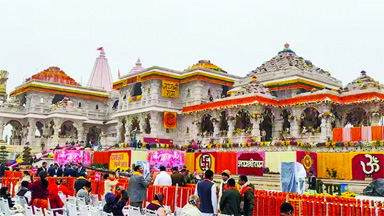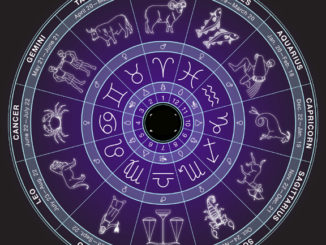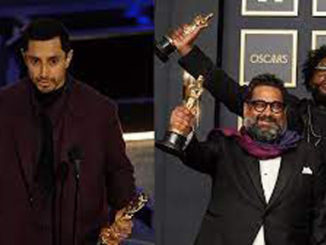
 Ayodhya (TIP) – Amid much fervour in the holy city of Ayodhya, Prime Minister Narendra Modi inaugurated the Ram Mandir and unveiled the idol of Ram Lalla on January 22. PM Modi also completed the Pran Pratistha rituals following the inauguration ceremony.
Ayodhya (TIP) – Amid much fervour in the holy city of Ayodhya, Prime Minister Narendra Modi inaugurated the Ram Mandir and unveiled the idol of Ram Lalla on January 22. PM Modi also completed the Pran Pratistha rituals following the inauguration ceremony.
“The supernatural moment of the consecration of Shri Ram Lala’s life in Ayodhya Dham is going to leave everyone emotional. It is my great pleasure to be a part of this divine program. Hail Siya Ram!,” PM Modi writes in a post on social media platform X.
The Ram Temple is constructed at the birthplace of Lord Ram. Notably, the grand event saw the participation of 7,000 VVIPs ranging from politicians to businessmen and celebrities such as Mukesh Ambani, Gautam Adani, Virat Kohli, and Amitabh Bachchan amongst others. The cost of the construction of Ram Temple stood at ?1,800 crore and was supervised by agencies such as Bengaluru-based National Institute of Rock Mechanics (NIRM), Larsen & Toubro Ltd and Tata Consulting Energies have supervised the construction of the temple.
Ahead of the inauguration ceremony, PM Modi inaugurated multiple projects in the holy city including Ayodhya International Airport, a railway station, a highway and the doubling of a railway line. These projects are constructed at an outlay of Rs 15,000 crore.
Meanwhile, earlier this month, the government approved the proposal to declare Ayodhya airport as an international airport and namedit as “Maharishi Valmiki International Airport, Ayodhyadham”. The development is significant as it’ll raise Ayodhya’s economic potential and enhance its significance as a global pilgrimage site, opening doors to foreign pilgrims and tourists. Ayodhya, with its deep cultural roots, is strategically positioned to become a key economic hub and pilgrimage site. The Ayodhya Airport will begin international operations beginning 2025.
Notably, the Ram Janmabhoomi issue has been at the heart of controversy for the last 31 years, following the demolition of the 400-year-old Babri Masjid by Hindutva sympathisers in 1992. In 2019, the five-judge constitutional bench of the Supreme Court led by Ranjan Gogoi, the former Chief Justice of India (CJI) passed the historic judgement, handing over the 2.77-acre land to Shri Ram Janmabhoomi Teerth Kshetra, the trust which has been set up for the construction and management of Ram Mandir. The Muslims were, however, given an alternative land to build a potential mosque.
The opening of Ram Mandir is touted to increase avenues of tourist attraction and infrastructure in Ayodhya. According to a report by Jefferies, the number of pilgrims is expected to jump to 1 lakh-1.5 lakh per day in the religious city.
In terms of Ayodhya’s impact as India’s new tourist spot, it is estimated that it could attract 50 million tourists per year, says the report. “A $10bn makeover (new airport, revamped railway station, township, improved road connectivity, etc) will likely drive a multiplier effect with new hotels & other economic activities. It can also set a template for infra-driven growth for tourism,” says the report.
PM dedicated 51-inch black stone idol of the five-year-old god, or Ram Lalla
Modi presided over the ceremony dedicated to the 51-inch black stone idol of the five-year-old god, or Ram Lalla, in front of a thousands-strong crowd comprising India’s most celebrated dignitaries from every walk of life. He then spent nearly 40 minutes delivering a rousing speech where he fused faith and governance, transforming the holy moment into a milestone for nation-building and laying a road map for the future course of India.
“22nd January 2024 is not a mere date, it’s the origin of a new kal chakra (era)… We have to expand our consciousness from dev to desh, Ram to rashtra – from deity to nation,” he said.
Carrying a silver “chattra”,or umbrella, for the deity, Modi cantered up 32 steps to enter the temple around 12.10pm on a crisp chilly day with the winter sun shining down on the 8,000-odd guests comprising top industrialists, sportspersons, politicians, film stars, writers and journalists, and ascetics.
He walked through five halls, or “mandaps”, decorated with yellow and saffron marigold flowers, as chants of “Jai Shri Ram” coursed through the crowd like a Mexican Wave. Dressed in a cream kurta paired with a dhoti and patka, he took the pledgefor the consecration ceremony and later offered the first prayers to the deity.
“This is a temple of national consciousness in the form of Ram. Lord Ram is India’s faith, foundation, idea, law, consciousness, thinking, prestige and glory,” he said as the crowd broke into applause.
Built in the traditional Nagara style of architecture with intricate carvings of deities adorning its white marble walls, the temple spans 380 feet in length and 250 feet in width, with its tallest spire at 161 feet. Supported by 392 columns and accessible through 44 doors, the temple is built on the 2.77-acre plot which Hindus believe to be the birthplace of Lord Ram and which was locked away behind the Ram Janmabhoomi-Babri Masjid dispute for 150 years, before the Supreme Court’s landmark verdict in 2019.
“Our Ram is finally here… he will no longer live in a tent,” Modi said, referring to the makeshift temple where pilgrims offered prayers to the infant deity as rival claims over the main site were litigated in the courts after the 1992 razing of the Babri Masjid.
Most opposition parties stayed away from the event, blaming the BJP and Modi of hijacking the event and blurring the line between religion and governance.
“Siyaram (Sita-Ram) reside in those hearts who honour tradition, ethics and dignity,” Samajwadi Party chief Akhilesh Yadav posted on X after the consecration event.
The opening of the temple is expected to catapult Ayodhya to one of the focal nodes of the Hindu faith, and draw hundreds of thousands of devotees every year. In anticipation of the influx of pilgrims to easily the largest temple to Ram in India, the authorities have spruced up the centuries-old town, pouring in ?30,508 crore to implement a sweeping facelift.
It marks an extraordinary triumph for Hindu groups, which have long argued that the site is the birthplace of Lord Ram and see the opening of the temple as a civilisational moment. It is also an important victory for the BJP, which has included the construction of the Ram Temple as one of its core promises in its election manifesto for three decades; the temple will almost certainly figure as one of the party’s top achievements in the narrative for the 2024 general elections.
The serene 40-minute ceremony on Monday was in stark contrast to the tension and bloodshed that the plot came to be associated with over the last century, and the thousands who died in the riots that followed the demolition of the Babri Masjid on December 6, 1992. Modi made a reference to the concerns around communal conflagration in his speech, but proceeded to dismiss the speculation as overblown assumptions.
“Ram is not fire, he is energy, he is not conflict but solution. Ram does not belong only to us but to all, Ram is not just present but is infinity,” Modi said.
The ceremony, also attended by one of the original litigants in the title suit, signalled the beginning of a new chapter for Ayodhya and the lives of its residents.
“For us the dispute was over the day when the Supreme Court ruled in favour of the temple in 2019. It’s good that the Ram Temple has come up and this will bring additional focus on the temple town and hopefully better fortunes too,” said Ansari, whose father Hashim Ansari was the oldest litigant of the case.
Modi performed the final leg of weeklong Vedic rituals by symbolically opening the eyes of the idol with a golden stick, chanting holy verses before placing flower petals at the feet of the deity and joining his palms in prayer. He then prostrated himself before the deity and circled a sacred flame. The 51-inch idol adorned a golden crown, golden ornaments, and a golden bow and arrow.
Outside, a military helicopter showered petals on the temple and the audience. Traditional clarinets played devotional music as thousands clad in saffron danced in the streets outside, waving saffron flags and bursting firecrackers.
“Jai Shri Ram, ho gaya kaam (hail lord Ram, the work has been accomplished),” Saurabh Shukla, a student of Saket College in Ayodhya shouted joyously and said he would like to be among the first few to visit the grand temple when it opens for all on Tuesday.
Uttar Pradesh governor Anandiben Patel, chief minister Yogi Adityanath and Rashtriya Swayamsewak Sangh (RSS) chief Mohan Bhagwat were present when the PM reached sanctum sanctorum. Bhagwat was seated next to Modi during the ceremony and performed some rites alongside him.
Before the PM’s address, he accepted two spoons full of charnamrit, to break his 11-day fast, from Govind Dev Giri, the treasurer of the Ram Janmabhoomi Teerth Kshetra Trust, which is overseeing the construction of the temple. Later in the day, he went to Kuber Tila and worshipped Lord Shiva at a restored temple.
As evening fell, the shimmering lights from around one million earthen lamps lit up Ayodhya in a golden hue. Across the country, people came out of their homes to light lamps to mark the consecration ceremony, led by PM Modi.
“It’s a momentous occasion as dreams of several generations have come true and we hope that the temple will also bring about a change in our fortunes as well,” said Arvind Dubey, who sells construction material near Karsewakpuram, an area purchased by Vishwa Hindu Parishad and named after temple volunteers who were killed in the police firing of 1990.
Lamps, fireworks, bhajans: Festive fervor in country
Thousands clad in saffron danced in the streets waving saffron flags, rangolis were made and temples were lit up in diyas as people gathered to recite hymns and devotional songs about the Hindu god Ram across the country.
Diwali-like celebrations were held in cities, towns and villages in most states as the country marked the day the Ram Temple in Ayodhya was thrown open following a consecration ceremony of the idol of the child god or Ram Lalla led by Prime Minister Narendra Modi. While central government and most states announced a half-day, till 2.30pm, others like Maharashtra declared a public holiday to mark the occasion. Some states such as Uttar Pradesh declared a dry day and prohibited the sale of meat dishes for the day.
People flocked to various temples to offer prayers, organised “havans” and community feasts and took out colourful processions through the streets.
In Delhi, people held Sundarkand recitals, took out rallies and organised community feasts as posters of Lord Ram and saffron flags with the deity’s picture dotted the city, devotional songs blared through loudspeakers and special screens beamed a live telecast of the “Pran Pratishtha”.
In Jammu, thousands of people flocked to the Raghunath temple. In Uttarakhand, a special aarti was performed at Har Ki Pauri in Haridwar. In Himachal Pradesh, a “Kar Sevak Samman” ceremony was organised in Shimla.
Defining event for developed India: PM
The inauguration of the Ram Temple marks the beginning of a new era and the grand shrine will witness the rise of a developed and magnificent India, Prime Minister Narendra Modi said on Monday as he urged the citizens to lay the foundation of the country for the next 1,000 years.
In a speech that blended faith with politics and transformed a holy religious event into a milestone for nation building, Modi also spoke about the power and legacy of Lord Ram, sought forgiveness for the delay in building a temple, and complimented how the nation had delicately untied the knots of history.
“Today, I feel with a pure heart that the cycle of time is changing… we have to lay the foundation of India for the next 1,000 years,” Modi said.
The PM referred to the Ram Janmabhoomi-Babri Masjid dispute, and said once there were concerns that if the temple came up, it would lead to violence.
“The construction of this temple of Ram Lalla is also a symbol of peace, patience, mutual harmony and coordination of Indian society. We are seeing that this construction is not giving birth to any fire, but to energy,” he said.
“Ram is not fire, he is energy, he is not conflict but solution. Ram does not belong only to us but to all. Ram is not just present but is infinity.”





Be the first to comment